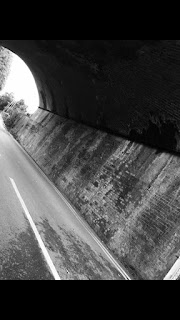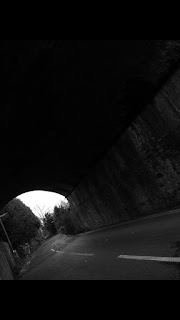
 Because we are filming our movie opening outdoors, natural lighting is the predominant source of light that we will be using. Because of this, it was important we analysed the lighting of our location, considering what time it starts to get dark and when there the is specific period of dusk that we aim to film in. As well as this we wanted to analyse the artificial lighting with the lamp posts that scatter the paths and decipher exact location points to use. If we choose to include darker scenes or a progress of time with editing through ellipsis we will need to considering the artificial lighting of lampposts or even our own lighting. We liked filming with the faint glow of the lampposts however the yellowing lighting was almost to warm to work with and gave off a safe and warm feeling which is not the feeling we aim to get across in our horror movie opening. The lampposts also reinforced the idea that this was an inhabited, almost metropolitan area whereas we choose this particular area of forestry in attempt to get across feelings of a desolate, lonely uninhabited area. Additionally, The lampposts frequently had signs or notations attached to them which made the whole atmosphere seem civilized, safe, normal and formal however as a horror movie we wanted to empathize feelings of fear.
Because we are filming our movie opening outdoors, natural lighting is the predominant source of light that we will be using. Because of this, it was important we analysed the lighting of our location, considering what time it starts to get dark and when there the is specific period of dusk that we aim to film in. As well as this we wanted to analyse the artificial lighting with the lamp posts that scatter the paths and decipher exact location points to use. If we choose to include darker scenes or a progress of time with editing through ellipsis we will need to considering the artificial lighting of lampposts or even our own lighting. We liked filming with the faint glow of the lampposts however the yellowing lighting was almost to warm to work with and gave off a safe and warm feeling which is not the feeling we aim to get across in our horror movie opening. The lampposts also reinforced the idea that this was an inhabited, almost metropolitan area whereas we choose this particular area of forestry in attempt to get across feelings of a desolate, lonely uninhabited area. Additionally, The lampposts frequently had signs or notations attached to them which made the whole atmosphere seem civilized, safe, normal and formal however as a horror movie we wanted to empathize feelings of fear. The evident images i have included picture me doing some of our first camera trials, as a preliminary filming task. Because we are using multiple cameras, we wanted to experiment with the tripod and appropriate angles and views to use. We took the tripod and Go-Pro kit to our location and did trials of some of the shots we wanted to capture as well as panoramic views of our location. We also captured images of the location at different points during the evening to see when the best light was for filming because we have decided on filming over different days to get the optimum light intensity and appropriateness for our filming rather than having the problem of filming as night draws in with the fast pace at which it gets dark. For this reason we decided the best plan for our filming progress was to film from 2;30-4 on one day and then repeat these exact same hours the following day. If we completed evening filming over one evening it would be likely the light in our shots wouldn't co-ordinate or match making our film less effective.
The evident images i have included picture me doing some of our first camera trials, as a preliminary filming task. Because we are using multiple cameras, we wanted to experiment with the tripod and appropriate angles and views to use. We took the tripod and Go-Pro kit to our location and did trials of some of the shots we wanted to capture as well as panoramic views of our location. We also captured images of the location at different points during the evening to see when the best light was for filming because we have decided on filming over different days to get the optimum light intensity and appropriateness for our filming rather than having the problem of filming as night draws in with the fast pace at which it gets dark. For this reason we decided the best plan for our filming progress was to film from 2;30-4 on one day and then repeat these exact same hours the following day. If we completed evening filming over one evening it would be likely the light in our shots wouldn't co-ordinate or match making our film less effective.We wanted to annihilate any possible difficulties we would have with filming before we actually went into the official filming process so already we took into account issues like camera memory, sound clarity and Go-Pro set up that could occur.
We also did a comparison trial with a Nikon L840 and a Olympus VG-180 to analyse which camera had the most clarity, memory, best playback and was most appropriate for our movie- which was the Nikon.

 On our location and camera trials we also investigated the public interaction we would have in our location and tried to gain an understanding on the amount of passers by or interruptions to filming we would have. The later it got, the less passers by there were- however this proved a problem because we cannot film in the way we aim to with no lighting. On average, every ten-fifteen minute interval there was a by passer which we will take into account for future filming.
On our location and camera trials we also investigated the public interaction we would have in our location and tried to gain an understanding on the amount of passers by or interruptions to filming we would have. The later it got, the less passers by there were- however this proved a problem because we cannot film in the way we aim to with no lighting. On average, every ten-fifteen minute interval there was a by passer which we will take into account for future filming.
In these photographs we have captured the Tunnel that we wish to film using, because it is one of the most prominent scenes in our film. We have edited the imagery to make it have more contrast and used a black and white filter to define the dark emotions we will be representing in our film opening. These images also view the tunnel from different angles and ends so are going to effectively help us to achieve the perfect camera angles to film the final scene from. The photographs also include the two key aspects of the movie- the road (where the main action happens and the girl is hit by a car) and the tunnel (where the film opening concludes).
No comments:
Post a Comment